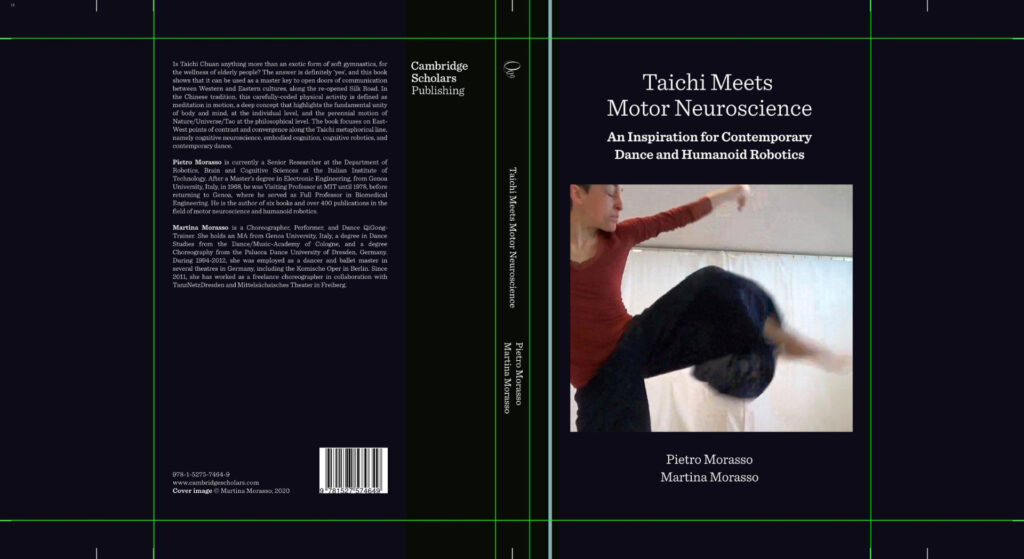ピエトロ・モラッソ先生の新しい著書が出版されました.
https://www.cambridgescholars.com/product/978-1-5275-7464-9
Taichi Meets Motor Neuroscience: An Inspiration for Contemporary Dance and Humanoid Robotics
Pietro Morasso and Martina Morasso
ISBN: 1-5275-7464-4
ISBN13: 978-1-5275-7464-9
#アマゾンでも購入できます
https://www.amazon.co.jp/dp/1527574644
モラッソ先生は人間のリーチング運動時の手先速度がベル型になることを発見した世界的に有名な研究者で,私がジェノバ大学において在外研究を行っていたときの先生です.
https://sites.google.com/site/pietromorasso/
https://scholar.google.co.jp/citations?user=w6CqLWYAAAAJ&hl=ja
マルチナさんはモラッソ先生とプシケ・ジャノーニ(Psiche Giannoni)先生の一人娘で,ドイツを中心に活躍するコンテンポラリーダンスのパフォーマ兼指導者で,choreographerもされています.プシケ先生はイタリアで有名な理学療法士で,理学療法士を育成する学校(the ART Education and Rehabilitation Centre in Genoa)を設立し,長い間,責任者を務めておられました.3人とも私にとってはイタリアの家族のような存在です.
この本は父であるモラッソ先生と娘であるマルチナさんの専門を融合したもので,モラッソ先生にとってもこれまでの長い研究者としての道のりを総括したような内容になっています.
お二人から依頼を受けて,この本の冒頭に紹介文を書かせていただきました.私にとっても感慨深く,またイタリアと日本の間でやりとりしながらの楽しい執筆作業となりました.モラッソ先生とは,引き続きTime Base Generator(TBG)モデルの研究や乳幼児の運動評価などの研究を一緒に進めていきたいと思っています.
—————————————————————————
A short commentary on “Taichi meets Motor Neuroscience” by Pietro Morasso and Martina Morasso”
Toshio Tsuji, Hiroshima University, Hiroshima, Japan
This book is the first comprehensive discussion of Taichi and motor neuroscience together, providing inspiration for the future of contemporary dance and humanoid robotics.
The first author, Pietro Morasso, is recognized internationally as a leading scholar and thought leader in the field of motor neuroscience, and has investigated the neural control of movement, sensorimotor learning, rehabilitation engineering, anthropomorphic robotics and biological neural computation for over half a century. Importantly, he discovered the bell-shaped velocity profile in human reaching movements in 1981, stimulating numerous subsequent studies on the modeling of human movements.
The second author, Martina Morasso, is a choreographer and ballet master, teacher of performing arts, and university lecturer. She is the daughter of Pietro Morasso and Psiche Giannoni, a well-known Italian physiotherapist and the former director of the ART Rehabilitation and Educational Centre of Genoa, a school for post-graduate physiotherapists and medical doctors. Martina Morasso is well-versed in the performing arts of eastern cultures, including the Japanese arts of Butoh, Bunraku, and Noh.
As the starting point of this story, Martina Morasso adopted Taichi Chuan as a practice method around two decades ago. She later began to apply the practice for structuring choreographies and performances, in addition to training for herself and other professional dancers. Pietro Morasso told me that he initially considered this interest to be a fascination with a kind of “exotic flavor”, considering the popularity of eastern culture in many western countries, including yoga, martial arts, acupuncture, reiki, and sushi. Later, he began to understand that Taichi is a serious and deep practice if taken seriously, relating to a foundational pillar of many eastern cultures.
The book consists of six parts, beginning with Prolegomenon. Prolegomenon provides an overview to the background of the book from a philosophical point of view. The Equilibrium chapter discusses still stances (Ding Shi) and transitions in Taichi Chuan, comparing them with equilibrium control in motor neuroscience. Next, the Motion chapter explores the simple transition of equilibrium to the passive motion paradigm, including humanoid robotics and human-robot symbiosis. The Dance chapter proposes that Taichi Chuan has played a crucial role in the rejuvenation and innovation of contemporary and modern dance, and the Health chapter describes wide-ranging evidence that the practices of Taichi and Qigong are beneficial for general wellness in elderly populations, and for a variety of specific pathological conditions of the body, and discusses the basic “purification” of the mind-body linkage through increased awareness of the body. Finally, the Conclusion chapter summarizes five topics surrounding the Taijitu (the graphic symbol of Taiji) in which the authors investigate possible east-west points of contact and cross-inspiration: philosophy, neuroscience, robotics, dance, and health. The five elements may be a modern version of Yin-Yang Wu-Xing Thought, and the authors conclude that the choice of Taiji may provide a master key to open five different doors related to crucial aspects of culture.
Interestingly, the authors describe an analogy between the Taoistic “road” and the philosophical “river” evoked in the pánta rheî aphorism attributed to Heraclitus in Prolegomenon. Ancient Greek philosophers reached the limits of dualistic thinking, and were placed in a situation similar to postmodernism. Heraclitus’ approach to transcending dichotomy can be linked to the concept of “déconstruction” against logocentrism in Derridean thought. Taijitu does not mean dualism of yin and yang. Rather, its visual representation looks like a combination of black and white magatama (comma-shaped beads). In China, the representation of this concept is likened to the shape of two fish, called yin-yang fish. The black fish represents yin, and means falling on the right side, whereas white represents yang, and means rising on the left. The expansion of the area from the fish tail to the fish head shows how each spirit is born and gradually becomes more active, and eventually the yin tries to swallow the yang and the yang tries to swallow the yin. The yin then changes into the yang, and the yang changes into the yin. A fish eye-like white dot in the center of the yin indicates the yang in the yin, indicating that, no matter how strong the yin becomes, there is a yang in the yin, which then turns into the yang. The central point of the yang also indicates the yin in the yang; no matter how strong the yang becomes, there is a yin in the yang, which later turns into the yin. The Taijitu indicates that this process is infinitely repeated. This concept of black and white fish may have useful future-oriented implications for race-related conflict occurring in the modern world. Black and white fish are intertwined with each other to build a perfect circle. There is no dichotomy, and the two fish behave like the front and back of the Mobius strip.
Tao is always present, and is called “do” in Japan. Almost all Japanese martial arts, including ju-do, ken-do, and karate-do, as well as performing arts, such as sa-do (tea ceremony), ka-do (flower arrangement), and sho-do (calligraphy) include “do”. Taichi involves different properties of yin and yang while balancing. This book will prompt the reader to consider that there is always Taichi in their body and mind, which can potentially affect human movement, dance and health.
—————————————————————————



